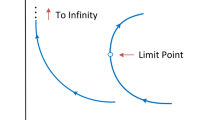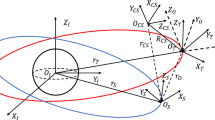Abstract
Recently new techniques for the design of energy efficient trajectories for space missions have been proposed that are based on the circular restricted three body problem as the underlying mathematical model. These techniques exploit the structure and geometry of certain invariant sets and associated invariant manifolds in phase space to systematically construct energy efficient flight paths. In this paper, we extend this model in order to account for a continuously applied control force on the spacecraft as realized by certain low thrust propulsion systems. We show how the techniques for the trajectory design can be suitably augmented and compute approximations to trajectories for a mission to Venus.
Similar content being viewed by others
References
Abraham R., Marsden J. (1978) Foundations of mechanics, 2nd edn Addison-Wesley, Reading, MA
Colonius, F., Kliemann, W. The dynamics of control. Systems & Control: Foundations & Applications. Birkhäuser Boston Inc., Boston, MA. With an appendix by Lars Grüne.
Dellnitz, M., Hohmann, A. The computation of unstable manifolds using subdivision and continuation. In: Broer, H., van Gils, S., Hoveijn, I., Takens, F. (ed.) Nonlinear dynamical systems and chaos, pp. 449–459, Birkhäuser, PNLDE 19, (1996)
Dellnitz M., Hohmann A. (1997) A subdivision algorithm for the computation of unstable manifolds and global attractors. Numerische Mathematik 75, 293–317
Dellnitz M., Junge O. (1999) On the approximation of complicated dynamical behavior. SIAM J. Numer. Anal. 36(2): 491–515
Dellnitz M., Junge O., Thiere B. (2001) The numerical detection of connecting orbits. Discrete Contin. Dyn. Syst. Ser. B 1(1): 125–135
Deuflhard P., Bornemann F. (2002) Scientific computing with ordinary differential equations, Texts in Applied Mathematics, Vol. 42. Springer-Verlag, New York
Deuflhard P., Pesch H.-J., Rentrop P. (1976) A modified continuation method for the numerical solution of nonlinear two-point boundary value problems by shooting techniques. Numer. Math. 26(3): 327–343
ESA Venus Express mission definition report. European Space Agency ESA-SCI, 6 (2001)
Fabrega, J., Schirmann, T., Schmidt, R., McCoy, D. Venus Express: the first european mission to Venus. Int. Astronautical Congress, IAC-03-Q.2.06, 1–11 (2003)
Gerthsen C., Vogel H. (1993) Physik. Springer, Berlin
Gómez G., Jorba À., Simó C., Masdemont J. (2001) Dynamics and mission design near libration points. Vol. III, World Scientific Monograph Series in Mathematics, Vol. 4 World Scientific Publishing Co. Inc., River Edge, NJ
Hairer, E., Nørsett, S.P., Wanner, G.: Solving ordinary differential equations. I. Non-stiff problems. Series in Computational Mathematics, Vol.8, 2nd edn. Springer-Verlag, Berlin, (1993).
Koon W., Lo M., Marsden J., Ross S. (2000a) Heteroclinic connections between periodic orbits and resonance transitions in celestial mechanics. Chaos 10, 427–469
Koon, W., Lo, M., Marsden J., Ross, S. Shoot the moon. In: AAS/AIAA Astrodynamics specialist conference, Florida, 105, 1017–1030 (2000b)
Koon W., Lo M., Marsden J., Ross S. (2002) Constructing a low energy transfer between jovian moons. Contemp. Math. 292, 129–145
Lo M., Williams B., Bollman W., Han D., Hahn Y., Bell J., Hirst E., Corwin R., Hong P., Howell K., Barden B., Wilson R. (2001) Genesis mission design. J. Astronautical Sci. 49, 169–184
McGehee R. Some homoclinic orbits for the restricted 3-body problem. PhD thesis, University of Wisconsin, (1969)
Meyer K., Hall R. (1992) Hamiltonian mechanics and the n-body problem. Applied Mathematical Sciences, Springer-Verlag, Berlin
Stoer J., Bulirsch R. (2002) Introduction to numerical analysis, Vol. 12. Springer-Verlag, New York
Szebehely V. (1967) Theory of orbits—the restricted problem of three bodies. Academic Press, New York
von Stryk, O. Numerical solution of optimal control problems by direct collocation. In: Bulirsch, R., Miele, A., Stoer, J., Well, K.-H. (ed.) Optimal control—calculus of variations, optimal control theory and numerical methods, Internat. Ser. Numer. Math., pp. Vol. 111, 129–143. Birkhäuser, Basel (1993)
Author information
Authors and Affiliations
Corresponding author
Rights and permissions
About this article
Cite this article
Dellnitz, M., Junge, O., Post, M. et al. On target for Venus – set oriented computation of energy efficient low thrust trajectories. Celestial Mech Dyn Astr 95, 357–370 (2006). https://doi.org/10.1007/s10569-006-9008-y
Received:
Accepted:
Published:
Issue Date:
DOI: https://doi.org/10.1007/s10569-006-9008-y




